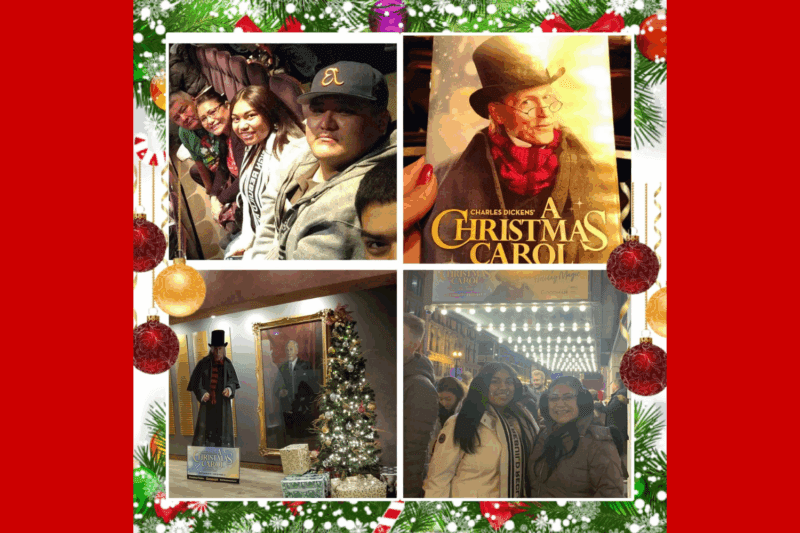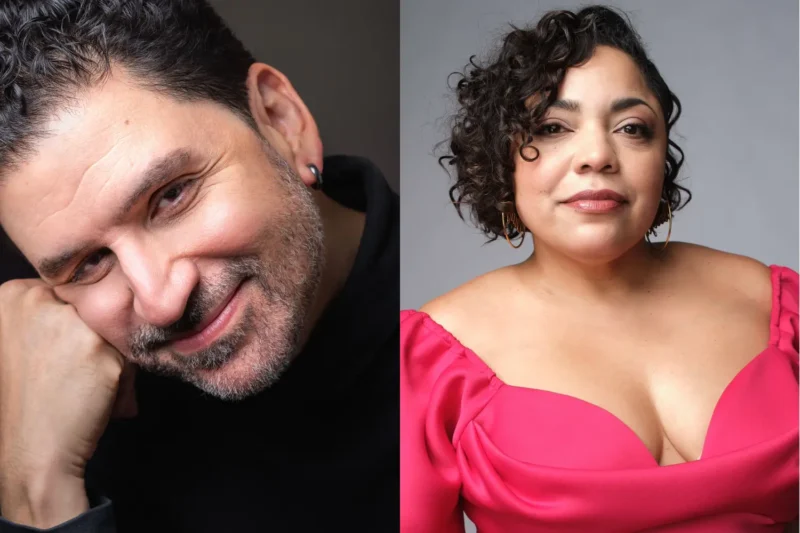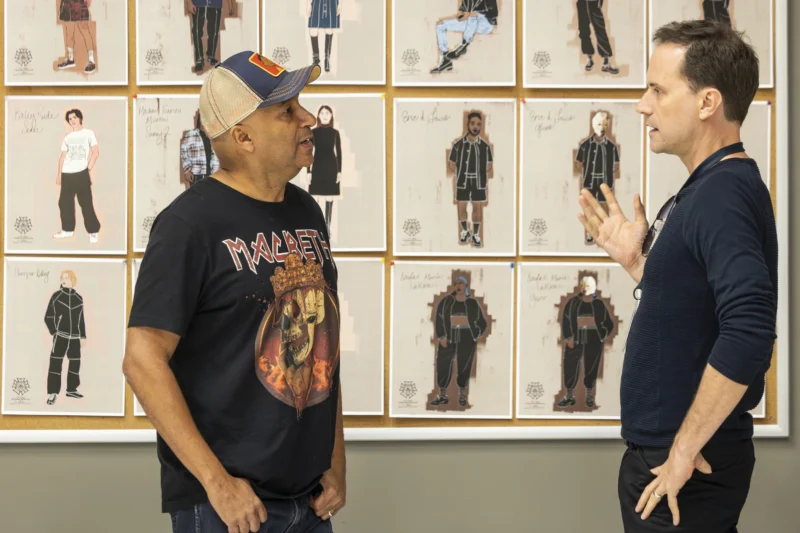Revolution(s) is on stage through November 9.
By Anna Rogelio Joaquin, School Programs Manager
ANNA ROGELIO JOAQUIN: You are working on Revolution(s) as the associate music supervisor, music director, conductor and bass. That’s a lot of roles! What do each of them entail?
PAUL MUTZABAUGH: The chief role of associate music supervisor on this production is to support the music supervisor (Jason Michael Webb) in whatever way is needed. Jason is in charge of the overall musical vision and arrangements for this show, and my job is to be entirely knowledgeable and proficient with the DNA of his work to be able to support him in his presence or in his absence. As the music director, I am responsible for maintaining the musical excellence of the production, from the first rehearsal to the closing performance. This includes teaching the actors the music, giving direction to the band members and providing feedback along the way. Additionally, I work with the director, choreographer, sound designer and other creative team members to support changes or revisions that occur during the rehearsal process. As conductor, my job is to lead the band and the actors, which includes initiating all of the musical numbers during the show and giving various cues during each song, providing clarity and comfort. This show is a unique situation in which I’ll be conducting from the bass chair during the show, whereas it is typically more common for a pianist/keyboardist to assume the conductor role. As bassist, I will be playing the electric bass guitar as well as a Moog bass synthesizer.
ANNA: What drew you to working on music for theater? How did you get into it?
PAUL: While I have been a professional musician for 25 years, I have only been working in the musical theater avenue in the very recent. My career has spanned a variety of genres and scenes, and through different connections, I have been recommended for some top-level theater productions over the past few years. I grew to really appreciate the collaborative nature of the rehearsal process, coupled with the high professional standard required of the multitude of people working on a show. I have found a unique fulfillment in the world of musical theater, and some of the most meaningful moments of my career have come in this discipline.
ANNA: What is the typical process for music directing a show, from getting the offer to getting the music on stage?
PAUL: Prior to the first cast rehearsal, I familiarize myself with the entirety of the script and songs, as well as arrangements and orchestrations (which are often in various stages of completion). It is then my job to teach the actors all of the music that they will be singing, typically occurring in the first week or two of rehearsal. From there, during the staging of the work, it is my job to support the Director’s vision while we rehearse the various scenes of a show. I will often (but not always) be tasked with playing rehearsal piano during this process. If/when adjustments in the music are needed to accommodate the stage action, I will be involved in those decisions and solutions. Toward the end of the cast rehearsal process, the orchestra will rehearse the songs on their own (without the actors), which I am responsible for leading. Ultimately, the cast and musicians come together for a Sitzprobe, a complete rehearsal of singing and playing all of the musical elements of the show together for the first time—always a thrilling day! Once we move into the theater, I am responsible for continual musical support as we translate the director’s vision onto the actual stage, eventually adding the orchestra to these tech rehearsals. Finally, we arrive at dress rehearsals and performances. During preview performances, changes are always being implemented. It is my job as music director to collaborate expertly and swiftly with the other departments as the show narrows its final focus toward its ultimate “frozen” state. As each stage of production moves to the next, I am tasked with continually analyzing and improving the level of musical excellence, relating to both the cast and the musicians.
ANNA: Where will the musicians be during the show?
PAUL: The current plan is to have the musicians on stage, visible to the audience. The band’s physical space will be intentionally woven into the broader scenic design of the show. There will also be a few actors who play instruments on stage during the performance, as part of the storytelling of the work.
ANNA: What kinds of technology do you use to sync up conducting with the musicians?
PAUL: A common practice in modern musical theater is to employ the use of the “conductor cam,” short for “conductor camera.” There is a video camera that captures the actions of the Conductor and displays them in real time on various monitors throughout the theater. These monitors live in a few locations in the theater, including in the stage manager’s booth, at the back of the house facing the stage (usually at Mezzanine level, visible to the actors), and at individual musicians’ stations in the orchestra pit. Because a conductor might not always be visible in plain sight, the camera is a helpful tool to be able to coordinate various cues within a song across many remote locations. There will also be a music director talkback microphone that I speak into on occasion that is fed to the musicians’ headphones. Such examples would include count-offs for songs, musical cues of a variable nature that are dependent on stage action and sometimes for relaying real-time adjustments in the music if something out of the ordinary transpires and needs immediate attention.
ANNA: What is your favorite moment of music in the show?
PAUL: Heading into rehearsal, the songs “Hold the Line” and “Rabbit’s Revenge” are among the top contenders. Both songs have a relentless, percolating energy and groove while also making use of wide dynamic ranges and different musical approaches, both vocally and instrumentally.
ANNA: What do you hope students notice in the music when they come see the show?
PAUL: I hope that the students take notice of both the obvious and the subtle ways that the music supports the overall work. Often, a song presents new and crucial information to the story and to character development. Sometimes, music is the backdrop for important dialogue in a scene. Both scenarios are equally important. Also, I encourage the students to listen for and be aware of the wide range of musical textures that are created in the arrangements and orchestrations. While we are only a band of five people, the aim is that we make the most of the sonic options we have access to. Nearly all of us will be playing multiple instruments throughout the show. Finally, I hope that the students recognize the partnership of the actors with the band musicians. One of my most important responsibilities as music director is to encourage a sense of curiosity and appreciation in everyone who contributes musically to this production. I feel that we are at our best when we are enjoying and engaged in each other’s excellence.
This article is adapted from a study guide created by The Goodman’s Education and Engagement Department for the Student Matinee Series. To view the full study guide, click here.




